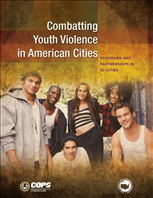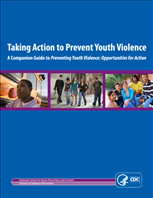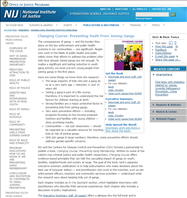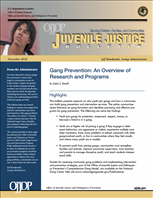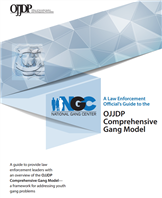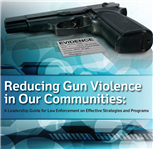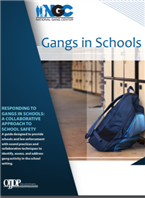A Parent's Quick Reference Card Recognizing and Preventing Gang Involvement
This quick reference guide provides common warning signs of gang involvement, but may not be all-encompassing. Parents should look for multiple signs to indicate possible gang involvement because some of these indicators alone, such as clothes or musical preferences, are also common among youth not involved in gangs. Parents are encouraged to familiarize themselves with local gang symbols, seek help early, and consider contacting school personnel, local law enforcement, faith leaders, and community organizations for additional assistance.
Combatting Youth Violence in American Cities
In March 2015, mayors were invited to participate in the development of a report that would serve as a tool for mayors, police chiefs, and school administrators throughout the nation who are committed to reducing youth violence in their cities. The mayors were asked to describe the approaches they were taking to reduce the problem, focusing on the kinds of partnerships that were involved and on the specific activities and practices undertaken to prevent or respond to youth violence in schools and neighborhoods. Comments also were sought on the most difficult problems encountered in implementing or maintaining their activities and practices, the keys to the formation of successful partnerships, and measures of the effectiveness of the approaches being described. Combatting Youth Violence in American Cities. This report contains descriptions of approaches taken to combat youth violence submitted by mayors and other officials in 30 cities of varying sizes (the smallest having a population of about 44,000) and representing every region of the country.
Gang Resistance Education (G.R.E.A.T.) Web site
Gang Resistance Education And Training (G.R.E.A.T.) is an evidence-based and effective gang and violence prevention program built around school-based, law enforcement officer-instructed classroom curricula. The Program is intended as an immunization against delinquency, youth violence, and gang membership for children in the years immediately before the prime ages for introduction into gangs and delinquent behavior.
Taking Action to Prevent Youth Violence - A Companion Guide to Preventing Youth Violence: Opportunities for Action
The information provided in this companion document, Taking Action to Prevent Youth Violence, will help communities learn more about the causes and impact of youth violence and identify actions each of us can take to stop youth violence.
Changing Course: Preventing Youth From Joining Gangs
Changing Course offers evidence-based principles that can halt the cascading impact of gangs on youth, families, neighborhoods and society at large. The goal of the book (and a separate executive summary publication) is to help policymakers who make decisions about the best use of taxpayer dollars — and practitioners who work in the trenches, such as law enforcement officers, teachers and community services providers — understand what the research says about keeping kids out of gangs.
Gang Prevention: An Overview of Research and Programs
This bulletin presents research on why youth join gangs and how a community can build gang prevention and intervention services. The author summarizes recent literature on gang formation and identifies promising and effective programs for gang prevention.
A Law Enforcement Official’s Guide to the OJJDP Comprehensive Gang Model
The OJJDP Comprehensive Gang Model provides a framework for coordinated community action to prevent youth from joining gangs and reduce street gang crime and violence. This brochure identifies law enforcement’s role in the process.
Reducing Gun Violence in Our Communities: A Leadership Guide for Law Enforcement on Effective Strategies and Programs
The overall goal of this guide is to provide information about notable programs and policing strategies that can be implemented by law enforcement agencies, regardless of size, in order to enhance the critical and life-saving mission of reducing gun violence. By highlighting innovative approaches developed by law enforcement departments and communities across the country, local leaders are encouraged to expand upon their current efforts in order to create a comprehensive program to enhance community and officer safety. The guide is structured with sections that address many existing gun violence problems including: gangs, youth violence, domestic violence, and federal firearms trafficking. If a community is experiencing a particular form of gun violence, the corresponding section of the guide offers practical information on effective countermeasures and ways to involve the community, as appropriate. Local law enforcement agencies, together with community leaders, can review this guide to learn about proactive programs and strategies that can be replicated and/or customized to fit into an individual agency’s policing model.
Responding to Gangs in Schools: A Collaborative Approach to School Safety
A guide designed to provide schools and law enforcement with sound practices and collaborative techniques to identify, assess, and address gang activity in the school setting.

